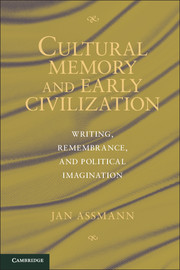1 - Memory Culture
Preliminary Remarks
from Part I - The Theoretical Basis
Published online by Cambridge University Press: 05 June 2012
Summary
The art and the culture of memory
The concept of ars memoriae or memorativa is firmly rooted in western tradition. The Greek poet Simonides, who lived during the 6th century BCE, is regarded as its founder. The Romans classified this form of art as one of five categories of rhetoric, and that was how it was handed down to the Middle Ages and the Renaissance. The underlying principle was as follows: “Those who would like to employ this part of their abilities should choose localities, then form mental images of the things they wanted to store in their memory, and place these in the localities. In this way, the order of the localities would preserve the order of the things, while the images would present the things themselves” (Cicero, De Oratore II 86, 351–354). The author (1st century BCE) of the Rhetorica ad Herennium, the most important classical text on the art of memory, distinguished between “natural” and “artificial” memory. Ars memoriae is the basis of artificial memory. It helps the individual to absorb and retain an extraordinary amount of knowledge, for example, for rhetorical use. This tradition remained effective until well into the 17th century, and has been documented by the English historian Frances Yates in a now classic book that has paved the way for countless new studies. However, this art of memory has very little in common with what is subsumed here under the concept of memory culture (Erinnerungskultur). The art of memory relates to the individual and presents techniques to help form personal memory. By contrast, “memory culture” is concerned with a social obligation and is firmly linked to the group. The question here is: “What must we not forget?” This question is generally a more or less explicit and a relatively central element of any group. Where it is central and integral to the group's identity and image of itself, one can speak of “memory communities” (Pierre Nora). In other words, memory culture is linked to the “memory that forms a community” (K. Schmidt, see n. 63). Unlike the art of memory that was a classical invention – albeit not exclusive to the West – memory culture is universal. It is virtually impossible to think of any social group where it is not to be found, in no matter how weak a form. That is why its history cannot be written in the way Frances Yates was able to deal with the art of memory. It is only possible to highlight some generic features that can be illustrated by recourse to some examples chosen arbitrarily. However, just as the Greeks occupy a special place in the field of classical ars memoriae, there is one nation that stands out in the history of memory culture – despite its universality – namely, the Israelites. They gave it a new form, and this was as influential for western history – among others – as the classical art of memory. Israel formed and preserved itself in accordance with the imperative “keep and remember.” Thus the Israelites became a people in a new and emphatic sense: they became the prototype of nationhood. Max Weber, who contrary to the spirit of his own time saw clearly the “perceived” or, as we would say today, the imagined nature of nationhood, wrote: “And behind all ethnic diversities there is somehow naturally the notion of the ‘chosen people,’” and this insight shows just how the principle of ethnic differences enabled Israel to develop a form that could serve as a model for the ideal. Any people that sees itself as a unit unlike other peoples, imagines itself somehow to be chosen. Weber was writing at a time when nationalism was at its peak, and it is only now that we can see just how universally valid this idea is. The principle of memory follows on from that of “being chosen”– being chosen means nothing less than a complex network of rigidly fixed obligations not allowing under any circumstances memory to fade away. Thus, Israel developed an enhanced form of memory culture that corresponds exactly to the artificial type described in Rhetorica ad Herennium.
- Type
- Chapter
- Information
- Cultural Memory and Early CivilizationWriting, Remembrance, and Political Imagination, pp. 15 - 69Publisher: Cambridge University PressPrint publication year: 2011

